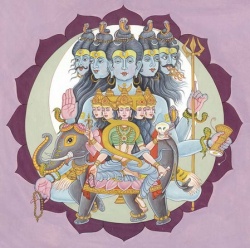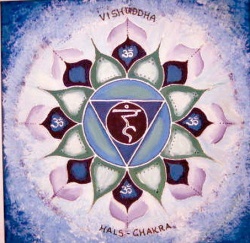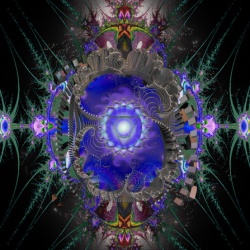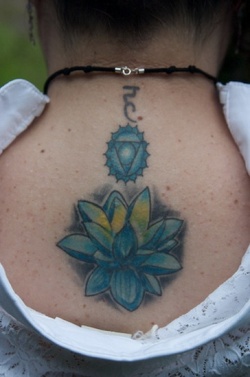Difference between revisions of "Vishuddha"
(Created page with "thumb|250px| <poem> Vishuddha (Sanskrit: विशुद्ध, Viśuddha) also known as Vishuddhi, is the fifth primary chakra according to the H...") |
|||
| Line 1: | Line 1: | ||
[[File:Vishuddhachakra.jpg|thumb|250px|]] | [[File:Vishuddhachakra.jpg|thumb|250px|]] | ||
<poem> | <poem> | ||
| − | Vishuddha (Sanskrit: विशुद्ध, Viśuddha) also known as Vishuddhi, is the fifth primary chakra according to the Hindu tradition. | + | Vishuddha (Sanskrit: विशुद्ध, [[Viśuddha]]) also known as [[Vishuddhi]], is the fifth primary [[chakra]] according to the Hindu tradition. |
Location | Location | ||
| − | Vishuddha is positioned at the neck region, near the spine, with its Kshetram or superficial activation point in the pit of the throat. | + | [[Vishuddha]] is positioned at the neck region, near the spine, with its Kshetram or superficial activation point in the pit of the throat. |
Appearance | Appearance | ||
| − | According to the Hindu culture this chakra is described as having a white color with 16 purple or smoke colored petals. Within the pericarp is a sky-blue downward pointing triangle, which contains in a circular region that is white (like the full-moon). This represents the element of [akasha] or aether. This region is represented by the deity Ambara, who is white in color, with four arms, holding a noose and a goad, making the gestures of granting boons and dispelling fear while seated upon a white elephant. | + | According to the Hindu culture this [[chakra]] is described as having a white color with 16 purple or smoke colored petals. Within the pericarp is a sky-blue downward pointing triangle, which contains in a circular region that is white (like the full-moon). This represents the element of [akasha] or aether. This region is represented by the deity Ambara, who is white in color, with four arms, holding a noose and a goad, making the gestures of granting boons and dispelling fear while seated upon a white elephant. |
Seed Mantra | Seed Mantra | ||
| Line 23: | Line 23: | ||
Function | Function | ||
| − | Vishuddha chakra is known as the purification centre. Here the nectar amrita drips down from the Bindu chakra and is split into a pure form and a poison. In its more abstract form, it is associated with higher discrimination, and it is associated with creativity and self-expression. When Vishuddha is closed, we undergo decay and death. When it is open, negative experiences are transformed into wisdom and learning. The success and failure in one's life depends upon the state of this chakra (polluted/clean). Guilty feeling is the most prominent reason for this chakra to block the Kundalini Energy moving upwards. It is associated with the element Akasha, or Æther, and the sense of hearing, as well as the action of speaking. | + | [[Vishuddha chakra]] is known as the purification centre. Here the nectar [[amrita]] drips down from the [[Bindu]] chakra and is split into a pure form and a poison. In its more abstract form, it is associated with higher discrimination, and it is associated with creativity and self-expression. When [[Vishuddha]] is closed, we undergo decay and death. When it is open, negative experiences are transformed into wisdom and learning. The success and failure in one's life depends upon the state of this chakra (polluted/clean). Guilty feeling is the most prominent reason for this [[chakra]] to block the [[Kundalini]] Energy moving upwards. It is associated with the element [[Akasha]], or [[Æther]], and the sense of hearing, as well as the action of speaking. |
[[File:Vishuddha mandala.JPG|thumb|250px|]] | [[File:Vishuddha mandala.JPG|thumb|250px|]] | ||
| − | Meditation upon this chakra is said to bring about the following siddhis or occult powers; vision of the three periods, past, present and future; freedom from disease and old age; destruction of dangers; and the ability to move the three worlds. | + | [[Meditation]] upon this [[chakra]] is said to bring about the following [[siddhis]] or occult powers; vision of the three periods, past, present and future; freedom from disease and old age; destruction of dangers; and the ability to move the three worlds. |
Lalana Chakra | Lalana Chakra | ||
| − | Closely related to Vishuddha is a minor chakra, located in the roof of the mouth, called Lalana. It has 12 red or white petals, that correspond to the virtues of respect, contentment, offense, self-control, pride, affection, sorrow, depression, purity, dissatisfaction, honor and anxiety. Inside is a red circular moon region. This acts as a reservoir for the nectar amrit. When vishuddha is inactive, this nectar is allowed to run downwards into Manipura, where it is consumed, resulting in physical degeneration. Through practices such as khechari mudra, however, the nectar can be made to enter Vishuddha, where it is purified, and becomes a nectar of immortality.. | + | Closely related to [[Vishuddha]] is a minor [[chakra]], located in the roof of the mouth, called Lalana. It has 12 red or white petals, that correspond to the virtues of respect, contentment, offense, self-control, pride, affection, sorrow, depression, purity, dissatisfaction, honor and anxiety. Inside is a red circular moon region. This acts as a reservoir for the nectar amrit. When vishuddha is inactive, this nectar is allowed to run downwards into Manipura, where it is consumed, resulting in physical degeneration. Through practices such as [[khechari mudra]], however, the nectar can be made to enter [[Vishuddha]], where it is purified, and becomes a [[nectar]] of [[immortality]].. |
Associations with the body | Associations with the body | ||
| − | This chakra is located in the neck and throat. Due to its association with hearing, it is related to the ears, and due to its association with speaking, it is associated with the mouth. Vishuddha is often associated with the thyroid gland in the human endocrine system. This gland is in the neck, and produces hormones essential for growth and maturation. | + | This [[chakra]] is located in the neck and throat. Due to its association with hearing, it is related to the ears, and due to its association with speaking, it is associated with the mouth. [[Vishuddha]] is often associated with the thyroid gland in the human endocrine system. This gland is in the neck, and produces hormones essential for growth and maturation. |
Practices | Practices | ||
[[File:Vishuddha 28aa.jpg|thumb|250px|]] | [[File:Vishuddha 28aa.jpg|thumb|250px|]] | ||
| − | In Kundalini yoga, Vishuddha can be opened and balanced through practices including asanas (such as shoulder-stand), pranayama, Jalandhara Bandha (throat lock), and Khecarī mudrā. This chakra can be cleaned/opened by meditation and also by practicing singing or playing instrumental music. | + | In [[Kundalini]] [[yoga]], [[Vishuddha]] can be opened and balanced through practices including [[asanas]] (such as shoulder-stand), pranayama, Jalandhara Bandha (throat lock), and Khecarī [[mudrā]]. This [[chakra]] can be cleaned/opened by meditation and also by practicing singing or playing instrumental music. |
Comparisons with other systems | Comparisons with other systems | ||
| − | The throat wheel is an important centre in the Highest Yoga traditions of Vajrayana. It is circular, red, with 16 upward pointing petals or channels. It is of particular importance for the practice of Dream Yoga. Correctly meditating upon it before going to sleep should produce lucid dreams, within which one can continue to practice yoga. | + | The throat wheel is an important centre in the Highest Yoga traditions of [[Vajrayana]]. It is circular, red, with 16 upward pointing petals or channels. It is of particular importance for the practice of Dream Yoga. Correctly meditating upon it before going to sleep should produce lucid dreams, within which one can continue to practice yoga. |
Western occultists make various differing kabbalistic associations with Vishuddha. Some associate it with the hidden sephirah Da'at, where 'wisdom' and 'understanding' are balanced in the supernal realm by the aspect of 'knowledge', a tangible idea, which is then expressed, leading to the act of the creation, others associate it with the sephirah Chesed and Geburah, mercy and strength, which are sephirah intimately associated with morality, and the concept that both expansion, as expressed by Chesed, and limitation, as expressed by Geburah, are necessary for the creation of individual beings. In terms of ethics, this is expressed by the yamas and niyamas ( do's and do nots ) of yoga. | Western occultists make various differing kabbalistic associations with Vishuddha. Some associate it with the hidden sephirah Da'at, where 'wisdom' and 'understanding' are balanced in the supernal realm by the aspect of 'knowledge', a tangible idea, which is then expressed, leading to the act of the creation, others associate it with the sephirah Chesed and Geburah, mercy and strength, which are sephirah intimately associated with morality, and the concept that both expansion, as expressed by Chesed, and limitation, as expressed by Geburah, are necessary for the creation of individual beings. In terms of ethics, this is expressed by the yamas and niyamas ( do's and do nots ) of yoga. | ||
Revision as of 16:34, 25 June 2013
Vishuddha (Sanskrit: विशुद्ध, Viśuddha) also known as Vishuddhi, is the fifth primary chakra according to the Hindu tradition.
Location
Vishuddha is positioned at the neck region, near the spine, with its Kshetram or superficial activation point in the pit of the throat.
Appearance
According to the Hindu culture this chakra is described as having a white color with 16 purple or smoke colored petals. Within the pericarp is a sky-blue downward pointing triangle, which contains in a circular region that is white (like the full-moon). This represents the element of [akasha] or aether. This region is represented by the deity Ambara, who is white in color, with four arms, holding a noose and a goad, making the gestures of granting boons and dispelling fear while seated upon a white elephant.
Seed Mantra
The bija mantra (seed sound) is the syllable हं haṃ, and is written in white upon the chakra. In the bindu or point above the mantra resides the deity Sadashiva, who has 5 faces and 10 arms. The right side of his body is a white Shiva, and the left half of the body is a golden Shakti. He is holding a trident, chisel, sword, vajra, fire, a great snake, a bell, a goad, and a noose, and is making the gesture of dispelling fear. He is clad in a tiger skin. His Shakti is Shakini, who is shining white, with five faces, three eyes each, and four armed, with a bow and arrow, noose, and goad, and seated on a red lotus.
Petals
Vishuddha has sixteen purple petals upon which are written the 16 Sanskrit vowels in golden;
अ a आ ā इ i ई ī उ u ऊ ū ऋ ṛ ॠ ṝ
ऌ ḷ ॡ ḹ ए e ऐ ai ओ o औ au अः ḥ अं ṃ
NB: Some vowels listed above do not strictly correspond to the grammatical definition of a Sanskrit vowel, specifically ॡ ḹ, अः ḥ, and अं ṃ. See Sanskrit Phonology for details.
The petals correspond to the vrittis of the mantra Ong [Aum], the Sama-mantras, the mantra Hung, the mantra Phat, the mantra Washat, the mantra Swadha, the mantra Swaha, the mantra Namak, the nectar Amrita, and then the seven musical tones.
Function
Vishuddha chakra is known as the purification centre. Here the nectar amrita drips down from the Bindu chakra and is split into a pure form and a poison. In its more abstract form, it is associated with higher discrimination, and it is associated with creativity and self-expression. When Vishuddha is closed, we undergo decay and death. When it is open, negative experiences are transformed into wisdom and learning. The success and failure in one's life depends upon the state of this chakra (polluted/clean). Guilty feeling is the most prominent reason for this chakra to block the Kundalini Energy moving upwards. It is associated with the element Akasha, or Æther, and the sense of hearing, as well as the action of speaking.
Meditation upon this chakra is said to bring about the following siddhis or occult powers; vision of the three periods, past, present and future; freedom from disease and old age; destruction of dangers; and the ability to move the three worlds.
Lalana Chakra
Closely related to Vishuddha is a minor chakra, located in the roof of the mouth, called Lalana. It has 12 red or white petals, that correspond to the virtues of respect, contentment, offense, self-control, pride, affection, sorrow, depression, purity, dissatisfaction, honor and anxiety. Inside is a red circular moon region. This acts as a reservoir for the nectar amrit. When vishuddha is inactive, this nectar is allowed to run downwards into Manipura, where it is consumed, resulting in physical degeneration. Through practices such as khechari mudra, however, the nectar can be made to enter Vishuddha, where it is purified, and becomes a nectar of immortality..
Associations with the body
This chakra is located in the neck and throat. Due to its association with hearing, it is related to the ears, and due to its association with speaking, it is associated with the mouth. Vishuddha is often associated with the thyroid gland in the human endocrine system. This gland is in the neck, and produces hormones essential for growth and maturation.
Practices
In Kundalini yoga, Vishuddha can be opened and balanced through practices including asanas (such as shoulder-stand), pranayama, Jalandhara Bandha (throat lock), and Khecarī mudrā. This chakra can be cleaned/opened by meditation and also by practicing singing or playing instrumental music.
Comparisons with other systems
The throat wheel is an important centre in the Highest Yoga traditions of Vajrayana. It is circular, red, with 16 upward pointing petals or channels. It is of particular importance for the practice of Dream Yoga. Correctly meditating upon it before going to sleep should produce lucid dreams, within which one can continue to practice yoga.
Western occultists make various differing kabbalistic associations with Vishuddha. Some associate it with the hidden sephirah Da'at, where 'wisdom' and 'understanding' are balanced in the supernal realm by the aspect of 'knowledge', a tangible idea, which is then expressed, leading to the act of the creation, others associate it with the sephirah Chesed and Geburah, mercy and strength, which are sephirah intimately associated with morality, and the concept that both expansion, as expressed by Chesed, and limitation, as expressed by Geburah, are necessary for the creation of individual beings. In terms of ethics, this is expressed by the yamas and niyamas ( do's and do nots ) of yoga.
In the system of the Sufi Lataif-e-sitta there are no Lataif in the throat, but there are three in the region of the heart which are arranged horizontally and not vertically. They are the Qalb, or heart, which is the battleground between the lower forces of the Nafs and the higher forces of the Ruh, or spirit; the Ruh which is said by some to be situated on the right hand side of the chest; and Sirr, or secret, between them both in the middle of the chest.
In Taoism, the position of lalana chakra in the roof of the mouth corresponds with a point known as 'The Heavenly Pool'.
Alternative names
Tantra: Akasha, Dwyashtapatrambuja, Kantha, Kanthadesha, Kanthambhoja, Kanthambuja, Kanthapadma, Kanthapankaja, Nirmala-Padma, Shodasha, Shodasha-Dala, Shodasha-Patra, Shodashara, Shodashollasa-Dala, Vishuddha, Vishuddhi
Vedas (late Upanishads): Kantha Chakra, Vishuddha, Vishuddhi
Puranic: Vishuddha, Vishuddhi



